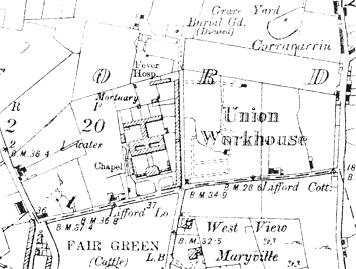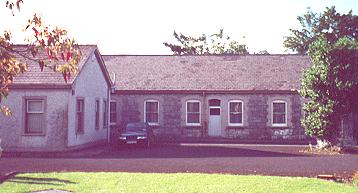Ennis, Co. Clare
Ennis House of Industry
Ennis erected a House of Industry in around 1775. It was funded by private subscriptions and governed by a corporation under an act of the Irish parliament. It was located at the north side of the town, adjoining the County Infirmary, and contained three male and four female wards.
Ennis Poor Law Union
Ennis Poor Law Union was formed on 1st July 1839 and covered an area of 221 square miles. Its operation was overseen by an elected Board of Guardians, 28 in number, representing its 18 electoral divisions as listed below (figures in brackets indicate numbers of Guardians if more than one):
Co. Clare: Bunratty, Clare, Clondagad (2), Clonlea, Cloony, Dysert, Ennis (7), Feenagh, Inagh, Inchacronan (2), Kilconry, Kilkreest, Killoan, Kilmaley (2), Newmarket, Quin (2), Ruann, Templemaley.
The Board also included 9 ex-officio Guardians, making a total of 37. The Guardians met each week on Wednesday.
The population falling within the union at the 1831 census had been 71,807 ranging from Kilconry (population 2,223) to Ennis itself (14,083).
The new workhouse, built in 1839-41, occupied a 6-acre site to the north of the town at Lifford. It was designed to accommodate 800 inmates and its construction cost £6,500 plus £2,100 for fixtures and fittings etc. It was declared fit for the admission of paupers on 1st December 1841 and admitted its first inmates two weeks later on 15th December. The site location and layout are shown on the 1922 map below.

Ennis workhouse site, 1922.
The workhouse building followed one of the standard designs by the Poor Law Commission's architect George Wilkinson, with a two-storey entrance block at the south containing administration offices, Guardians' board-room etc. Behind this stood a large three-storey accommodation block, one half of which housed female inmates, the other males. To the rear stood an infirmary block.
In common with other Unions in Ireland, Ennis suffered greatly during the famine years 1845-50. The workhouse was overwhelmed by the numbers wanting to enter and needed police protection for its doors. O'Connor (1995) illustrates the conditions in Ennis on Christmas Eve, 1846, with a letter by Captain Wynne, the District Inspector for Clare:
In 1847, some minimal relief came in the setting up of Government soup kitchens. However, this scheme lasted only six months and was replaced by a system of discretionary out-relief, which had to be funded by the local poor rate.
The demands of coping with the famine, coupled with incompetence and indifference on the part of the Board of Guardians, left the Union with huge debts which amounted to £20,000 by the end of 1849. The consequences of these financial difficulties included local tradesmen refusing supply basic foodstuffs such as Indian meal, or seizing workhouse furniture in lieu of payment. The government finally wrote off the workhouse debts in 1853.
At the 1901 census, the population of the Union was 19,772 with 26 officials and 482 inmates in the workhouse.
The workhouse later became St Joseph's Hospital. Virtually all the original workhouse buildings have now been demolished, the entrance block surviving until 1970. The only now surviving structure is a former fever ward at the north of the site.

Ennis workhouse fever ward from the south, 2000.
© Peter Higginbotham.
Records
Note: many repositories impose a closure period of up to 100 years for records identifying individuals. Before travelling a long distance, always check that the records you want to consult will be available.
- Clare County Library, The Manse, Harmony Row, Ennis.
Bibliography
- The Workhouses of Ireland by John O'Connor (Anvil Books, 1995)
- Sable Wings Over The Land by Ciaran O Murchadha (1998, CLASP Press).
Links
- None.
Unless otherwise indicated, this page () is copyright Peter Higginbotham. Contents may not be reproduced without permission.


